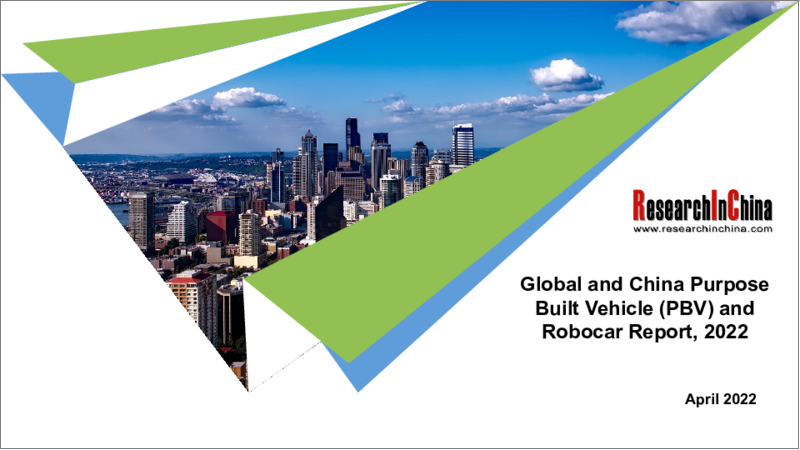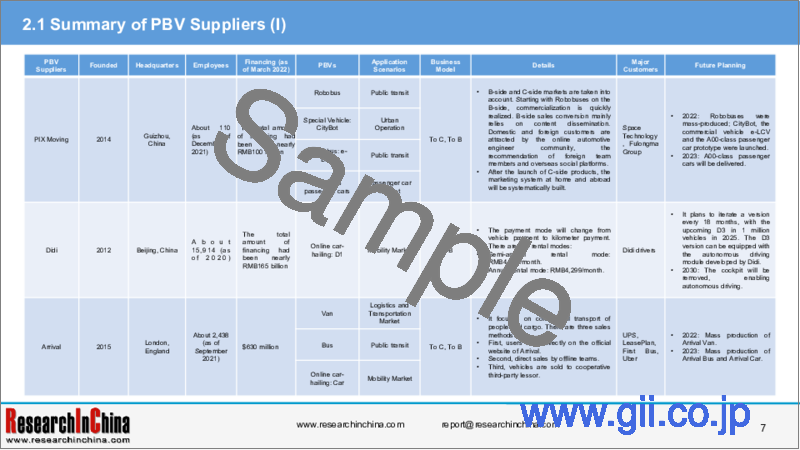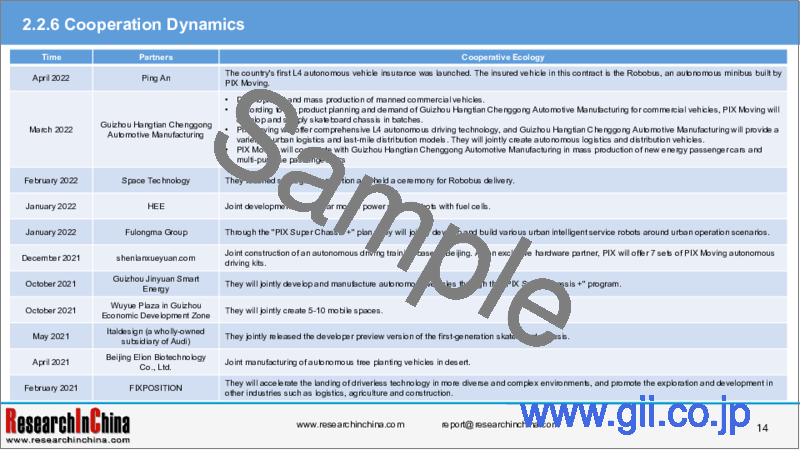|
|
市場調査レポート
商品コード
1073242
世界と中国のPBV (Purpose Built Vehicle)・Robocar市場の分析 (2022年)Global and China Purpose Built Vehicle (PBV) and Robocar Report, 2022 |
||||||
| 世界と中国のPBV (Purpose Built Vehicle)・Robocar市場の分析 (2022年) |
|
出版日: 2022年05月07日
発行: ResearchInChina
ページ情報: 英文 150 Pages
納期: 即日から翌営業日
|
- 全表示
- 概要
- 目次
PBV (Purpose Built Vehicle) とは、小型・中型バンやマルチボックスバンをベースとした特殊用途車を指します。PBVサプライヤーは、車体の上部と下部を独立して開発するアプローチを採用し、同一のシャーシ・プラットフォーム上に様々な車種を派生させ、カスタマイズニーズに対応します。従来の車両一貫開発と比較すると、開発期間の短縮や製品形態・収益モデルの多様化に対応できるという利点があります。
Robocar (ロボットカー) は、自動車のように自由に移動できるロボットのことを指し、レベル4の自動運転が可能な車両など、様々な形態が存在します。現在はロボタクシーやロボットバスが主体となっています。将来的にはRobocarもレベル5の自動運転に更新され、自己学習や自律的意思決定、様々なシナリオや悪天候に適応できるようになると言われています。
当レポートでは、世界と中国のPBVおよびRobocarの市場について分析し、技術の概略や現在の開発動向、主要サプライヤーのプロファイルと開発・販売動向などを調査しております。
目次
第1章 PBVとRobocar
- PBV (Purpose Built Vehicle)
- PBVの定義
- PBVの開発動向
- Robocar
- 定義と分類
- Robocarsの開発動向
第2章 PBVのサプライヤー
- PBVサプライヤーの概要
- PIX Moving
- Didi
- Arrival
- Rivian
- Canoo
- U Power
第3章 Robocarのサプライヤー
- Robocarサプライヤーの概要
- Baidu
- QCRAFT
- Pony.ai
- WeRide
- UISEE Technology
- iDriverPlus
- AgileX Robotics
- Hyundai Motor Group
PBV and Robocar research: new idea of building brick cars, a new car type for future mobility
Building brick cars moves the cheese of traditional OEMs.
Purpose built vehicle (PBV) refers to special purpose vehicles based on small/medium-sized van or multi-box van. PBV suppliers adopt the approach of independent development of upper and lower vehicle bodies, and derive various vehicle types on the same chassis platform, meeting customization needs. Compared with conventional integrated vehicle development, such a development method has unique features below:
Short development cycle and low cost
PBVs built on the same chassis don't need repeated development, which shortens the start-of-production and time-to-market of new models. The standardized chassis components can also be reused, reducing manufacturing costs.
For example, the use of "UP Super Board" developed by Shanghai U Power Technology Co., Ltd. cuts down the orignal 2 or 3 years of vehicle R&D cycle to 12 months, and the R&D costs by up to 60%.
Diversified PBV product forms
The flexible and changeable upper space of PBV allows a variety of product forms. For example, a PBV can be a logistics vehicle, a retail vehicle, a car, a bus, a sanitation vehicle, and so forth.
From the product layout of PBV suppliers, it can be seen that the product forms of PBV are led by three vehicle types: van, pickup and sedan. Wherein, PIX Moving enjoys the broadest range of product forms, involving four fields: passenger car, commercial vehicle, freight vehicle and special vehicle; U Power boasts the most abundant PBV product lineups and deploys five vehicle types, covering three fields: passenger car, commercial vehicle, and freight vehicle; with single PBV product form, Didi has only one product, D1, a customized car for the online ride-hailing mobility scenario. Didi plans to iterate a version every 18 months, to D3 in 2025 when 1 million units will be launched; and to remove the cockpit and realize autonomous driving in 2030.
Diversified PBV profit models
Through the lens of business models, PBV suppliers often apply the To B model. Among them, PIX Moving, Arrival and Rivian employ both To B and To C models. For instance, PIX Moving starts with Robobus at the business end in a bid for quick commercialization, and will build a complete marketing system after launching consumer products.
As for manufacturing, all suppliers except for Didi have their own production bases. Didi partners with BYD to produce D1 at BYD's base in Changsha city. In June 2021, Canoo started building a production line in Oklahoma, the US, and ceased the outsourcing contract with VDL Nedcar, opting to build cars by itself.
There are mainly three profit models: vehicle sales, rental, and software subscription & other value-added services. Didi and Arrival apply the rental model, but their rental schemes are different. Didi offers two rental schemes that target Didi drivers: half-year rental, with a monthly rent of RMB4,399; one-year rental, RMB4,299 per month. Arrival, however, aims at third-party lessors such as LeasePlan (in 2021, Arrival and LeasePlan signed a sales cooperation agreement for 3,000 vans). For profits, the supplier Canoo has begun to take into account both the subscription and vehicle sales models.
Is Robocar the ultimate form of PBV products?
The new idea of building brick cars gives birth to diversified vehicle forms, including Robocar, a robot that looks like a vehicle, can move freely and is capable of L4 autonomous driving. The product forms of Robocars are led by Robotaxi and Robobus. At present, Robotaxies built by Baidu, Pony.ai, QCRAFT and the like have begun to run. In the future, Robocars will also be upgraded to L5 autonomy, competent enough to self-learn, make decisions independently, and adapt to a variety of complex scenarios and inclement weather like rain and fog, and they will completely replace humans by then.
Table of Contents
1. PBV and Robocar
- 1.1 PBV
- 1.1.1 Definition of PBV
- 1.1.2 Development Trends of PBV
- 1.2 Robocar
- 1.2.1 Definition and Classification
- 1.2.2 Development Trends of Robocar
2. PBV Suppliers
- 2.1 Summary of PBV Suppliers
- 2.2 PIX Moving
- 2.2.1 Profile
- 2.2.2 Development History
- 2.2.3 Skateboard Chassis and Industrial Application Matrix
- 2.2.4 PBV Products
- 2.2.5 PBV Products - Robobus
- 2.2.6 Cooperation Dynamics
- 2.3 Didi
- 2.3.1 Profile
- 2.3.2 PBV Product Features and ADAS Functions
- 2.3.3 PBV Business Model and Cooperation Dynamics
- 2.4 Arrival
- 2.4.1 Profile
- 2.4.2 Development History and Planning
- 2.4.3 PBV Product Lineup
- 2.4.4 PBV Products - Arrival Van Classification
- 2.4.4 PBV Products - Arrival Van H3L4
- 2.4.4 PBV Products - Arrival Bus
- 2.4.4 PBV Products - Arrival Car
- 2.4.5 Cooperation Dynamics
- 2.5 Rivian
- 2.5.1 Profile
- 2.5.2 Financing
- 2.5.3 Development History
- 2.5.4 PBV Product Lineup
- 2.5.5 PBV Products - R1T Classification
- 2.5.5 PBV Products - R1T Features and ADAS Functions
- 2.5.5 PBV Products - R1S Classification
- 2.5.5 PBV Products - R1S Features and ADAS Functions
- 2.5.5 PBV Products - EDV Classification
- 2.5.5 PBV Products - EDV Features and ADAS Functions
- 2.5.6 Cooperation Dynamics
- 2.6 Canoo
- 2.6.1 Profile
- 2.6.2 Development History
- 2.6.3 PBV Product Lineup
- 2.6.4 PBV Products - Lifestyle Vehicle Classification
- 2.6.4 PBV Products - Lifestyle Vehicle Features and ADAS Functions
- 2.6.4 PBV Products - MPDV Classification
- 2.6.4 PBV Products - MPDV
- 2.6.4 PBV Product - Pickup
- 2.6.5 PBV Business Model
- 2.6.6 Cooperation Dynamics
- 2.7 U Power
- 2.7.1 Profile
- 2.7.2 PBV Products
- 2.7.3 Cooperation Dynamics
3. Robocar Suppliers
- 3.1 Summary of Robocar Suppliers
- 3.1.1 Operation Comparison of Robotaxi Products
- 3.2 Baidu
- 3.2.1 Profile
- 3.2.2 Main Technologies
- 3.2.3 Robocar Product Matrix
- 3.2.4 Robocar - Robotaxi Generations
- 3.2.4 Robocar - Features of Latest Generation Robotaxi
- 3.2.4 Robocar - Operation of Robotaxi
- 3.2.4 Robocar - Operation Model of Robotaxi
- 3.2.4 Robocar - Robotaxi Fleet Management Platform
- 3.2.4 Robocar - "Apolong" Robobus Generations
- 3.2.4 Robocar - "Apolong" Robobus 1.0
- 3.2.4 Robocar - Features of "Apolong" Robobus 2.0
- 3.2.4 Robocar - Autonomous Driving and Interaction Capabilities of "Apolong" Robobus 2.0
- 3.2.4 Robocar - Features of "Apolong" Robobus Apollo II
- 3.2.4 Robocar - Cockpit and Interaction of "Apolong" Robobus Apollo II
- 3.2.4 Robocar - Operation of "Apolong" Robobus
- 3.2.4 Robocar - Features of DeepWay Trunk Logistics Robocar
- 3.2.4 Robocar - Autonomous Driving Functions of DeepWay Trunk Logistics Robocar
- 3.2.4 Robocar - Features of Autonomous Mining Robotruck
- 3.2.4 Robocar - Commercialization Roadmap of Autonomous Mining Robotruck
- 3.2.4 Robocar - Retail Robocar
- 3.3 QCRAFT
- 3.3.1 Profile
- 3.3.2 Main Technologies
- 3.3.3 Robocar Product Matrix
- 3.3.4 Robocar - Dragon Boat One
- 3.3.4 Robocar - Operation of Dragon Boat One
- 3.3.4 Robocar - Dragon Boat Long
- 3.3.4 Robocar - Sharing Bus
- 3.3.4 Robocar - Dragon Boat Space
- 3.3.5 Operation Model
- 3.3.6 Dynamics in Robocar Development and Cooperation
- 3.4 Pony.ai
- 3.4.1 Profile
- 3.4.2 Financing
- 3.4.3 Main Technologies
- 3.4.4 Robocar Product Matrix
- 3.4.5 Robocar - Robotaxi Models
- 3.4.5 Robocar - Robotaxi Equipped with the 6th-Gen ADS
- 3.4.5 Robocar - Robotruck
- 3.4.5 Robocar - Robotruck Commercial Operation Roadmap
- 3.4.6 Dynamics in Robocar Development and Cooperation
- 3.5 WeRide
- 3.5.1 Profile
- 3.5.2 Financing
- 3.5.3 Main Technologies
- 3.5.4 Robocar Product Matrix
- 3.5.4 Robocar - Robotaxi
- 3.5.4 Robocar - Robobus
- 3.5.4 Robocar - Robovan
- 3.5.5 Operation Model
- 3.5.6 Dynamics in Robocar Development and Cooperation
- 3.6 UISEE Technology
- 3.6.1 Profile
- 3.6.2 Main Technologies
- 3.6.3 Robocar Product Matrix
- 3.6.4 Robocar - Features of Robocar for Autonomous Logistics
- 3.6.4 Robocar - Commercial Use and Cooperation Cases of Robocar for Autonomous Logistics
- 3.6.4 Robocar - Robocar for Autonomous Public Transport
- 3.6.4 Robocar - Commercial Use and Cooperation Cases of Robocar for Autonomous Public Transport
- 3.6.4 Robocar - Robocar in Passenger Car Field
- 3.6.4 Robocar - Features of Robocar for Autonomous Delivery
- 3.6.4 Robocar - Commercial Use and Cooperation Cases of Robocar for Autonomous Delivery
- 3.7 iDriverPlus
- 3.7.1 Profile
- 3.7.2 Main Technologies
- 3.7.3 Robocar Product Matrix
- 3.7.4 Robocar - Wobida, a Robocar for Autonomous Logistics
- 3.7.4 Robocar - Robocar in Passenger Car Field
- 3.7.4 Robocar - Robocar for Autonomous Sanitation
- 3.7.5 Dynamics in Robocar Development and Cooperation
- 3.8 AgileX Robotics
- 3.8.1 Profile
- 3.8.2 Mobile Robot Product Lineup
- 3.8.3 Mobile Robot - 4WD Chassis SCOUT 2.0
- 3.8.3 Mobile Robot - 4WD Chassis SCOUT MINI
- 3.8.3 Mobile Robot - Ackermann Chassis HUNTER 2.0
- 3.8.3 Mobile Robot - AGV Chassis TRACER
- 3.8.3 Mobile Robot - Tracked Chassis BUNKER
- 3.8.3 Mobile Robot - Omni-directional Chassis Ranger Mini
- 3.8.4 Cooperation Dynamics
- 3.9 Hyundai Motor Group
- 3.9.1 Profile
- 3.9.2 Robotic Product Lineup of Boston Dynamics
- 3.9.3 Future Mobility Vision of Hyundai Motor Group
- 3.9.4 Three Future Mobility Solutions of Hyundai Motor Group
- 3.9.5 PnD Module of Hyundai Motor
- 3.9.6 Hyundai Motor's Small Mobile Platform - MobED




